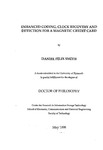Enhanced coding, clock recovery and detection for a magnetic credit card
| dc.contributor.author | Smith, Daniel Felix | |
| dc.contributor.other | School of Engineering, Computing and Mathematics | en_US |
| dc.date.accessioned | 2011-09-22T09:47:01Z | |
| dc.date.available | 2011-09-22T09:47:01Z | |
| dc.date.issued | 1998 | |
| dc.identifier | Not available | en_US |
| dc.identifier.uri | http://hdl.handle.net/10026.1/577 | |
| dc.description | Merged with duplicate record 10026.1/2299 on 03.04.2017 by CS (TIS) | |
| dc.description.abstract |
This thesis describes the background, investigation and construction of a system for storing data on the magnetic stripe of a standard three-inch plastic credit in: inch card. Investigation shows that the information storage limit within a 3.375 in by 0.11 in rectangle of the stripe is bounded to about 20 kBytes. Practical issues limit the data storage to around 300 Bytes with a low raw error rate: a four-fold density increase over the standard. Removal of the timing jitter (that is prob-' ably caused by the magnetic medium particle size) would increase the limit to 1500 Bytes with no other system changes. This is enough capacity for either a small digital passport photograph or a digitized signature: making it possible to remove printed versions from the surface of the card. To achieve even these modest gains has required the development of a new variable rate code that is more resilient to timing errors than other codes in its efficiency class. The tabulation of the effects of timing errors required the construction of a new code metric and self-recovering decoders. In addition, a new method of timing recovery, based on the signal 'snatches' has been invented to increase the rapidity with which a Bayesian decoder can track the changing velocity of a hand-swiped card. The timing recovery and Bayesian detector have been integrated into one computation (software) unit that is self-contained and can decode a general class of (d, k) constrained codes. Additionally, the unit has a signal truncation mechanism to alleviate some of the effects of non-linear distortion that are present when a magnetic card is read with a magneto-resistive magnetic sensor that has been driven beyond its bias magnetization. While the storage density is low and the total storage capacity is meagre in comparison with contemporary storage devices, the high density card may still have a niche role to play in society. Nevertheless, in the face of the Smart card its long term outlook is uncertain. However, several areas of coding and detection under short-duration extreme conditions have brought new decoding methods to light. The scope of these methods is not limited just to the credit card. | en_US |
| dc.language.iso | en | en_US |
| dc.publisher | University of Plymouth | en_US |
| dc.title | Enhanced coding, clock recovery and detection for a magnetic credit card | en_US |
| dc.type | Thesis | |
| dc.identifier.doi | http://dx.doi.org/10.24382/4711 | |
| dc.identifier.doi | http://dx.doi.org/10.24382/4711 |
Files in this item
This item appears in the following Collection(s)
-
01 Research Theses Main Collection
Research Theses Main


